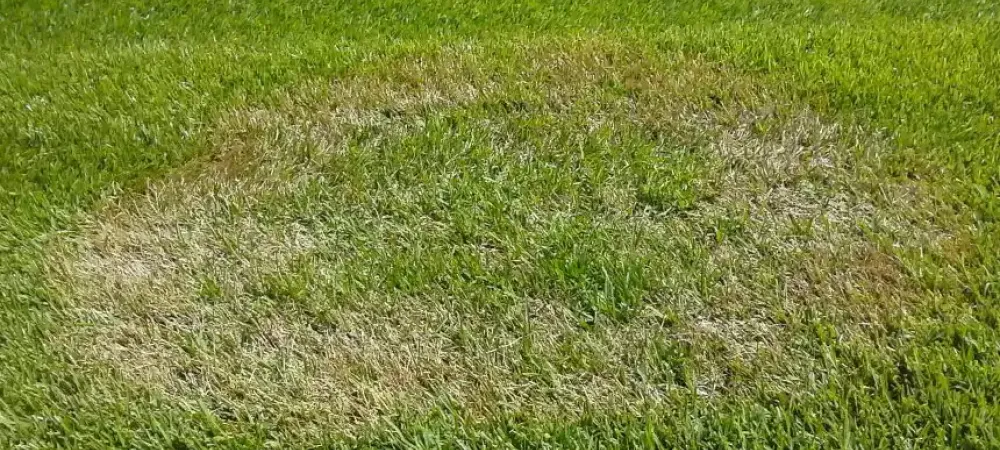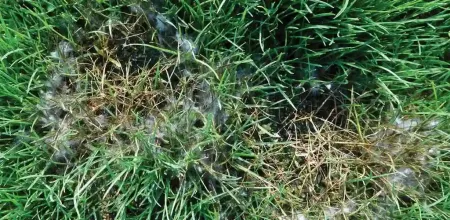The Most Common Types of Lawn Diseases in Georgia

Maintaining a lush and healthy lawn is a point of pride for many homeowners in Georgia. However, even the most well-tended lawns can fall victim to a variety of diseases. Identifying and treating these diseases promptly can prevent them from causing extensive damage. In this guide, we'll explore the most common types of lawn diseases in Georgia, how to identify them, and effective treatment methods.
Dollar Spot

How To Identify Dollar Spot
Dollar Spot is a fungal disease that is characterized by small, circular patches of bleached or straw-colored grass that are 1-6 inches in diameter. The affected areas may appear silver or tan and often have a sunken or depressed look. In the early stages, the disease can resemble the size of a silver dollar, hence the name. Dollar Spot is most prevalent in lawns with low nitrogen levels and thrives in warm, humid conditions. It is often seen during the summer months, during periods of high humidity and temperatures between 60-80°F.
To identify Dollar Spot, look for small circular patches of straw-colored grass that are about the size of a silver dollar. The affected areas may have a sunken appearance and can merge together to form larger patches. Look for thin, white mycelium strands (fungal threads) in the morning dew, which can help confirm the diagnosis. This disease predominantly affects turfgrasses like Kentucky bluegrass and fine fescue.
How To Get Rid Of Dollar Spot
To treat this common Georgia lawn disease, you should:
- Improve the nitrogen levels in your lawn by fertilizing with a nitrogen-rich fertilizer. Maintain balanced fertilization to keep the grass healthy and resilient.
- Water your lawn deeply and infrequently, as frequent shallow watering can promote the growth of the fungus.
- Ensure the lawn dries out between watering sessions, ideally watering the grass in the morning to allow the grass to dry out during the day,
- Improve lawn aeration to reduce thatch buildup and enhance soil drainage.
- Mow the lawn regularly at the recommended height for your grass type, ensuring the blades are sharp to avoid stressing the grass.
- In severe cases, apply fungicides containing active ingredients such as propiconazole, chlorothalonil, or thiophanate-methyl. Follow the manufacturer's instructions for application rates and timing.
Brown Patch

How To Identify Brown Patch
Brown Patch, also known as Large Patch, is a fungal disease that causes irregular, circular patches of brown, dead grass that can range from a few inches to several feet in diameter, surrounded by a dark ring of wilted turf. The grass blades within the patch may have a water-soaked appearance before turning brown. You may notice a musty smell coming from the infected areas.
This disease is particularly active in warm, humid weather, making it common in North Georgia, and is most common in tall fescue and ryegrass lawns. The patches often have a smoky or ash-colored ring at the outer edges.
How To Get Rid Of Brown Patch
Brown Patch can be treated when you:
- Ensure good air circulation around the lawn to reduce humidity levels by ensuring that your grass is not overcrowded or shaded by trees or shrubs.
- Remove thatch build up and improve lawn drainage to prevent water from pooling on the surface.
- Avoid over-fertilization, especially with nitrogen, during warm and humid periods.
- Water early in the morning to allow the grass to dry before nightfall.
- Maintain proper mowing height and frequency.
- If that doesn’t work, use fungicides containing azoxystrobin, propiconazole, or flutolanil. Apply at the first sign of disease and repeat as necessary according to the product label.
Pythium Blight

How To Identify Pythium Blight
Pythium Blight, also known as Grease Spot or Cottony Blight, is a fast-spreading fungal disease that causes large patches of grayish-brown or tan grass. The affected areas often appear as irregularly shaped patches of slimy, water-soaked turf that quickly turn brown, have a foul odor, and collapse.
This disease flourishes in warm, moist conditions and often affects lawns with poor drainage, making North Georgia especially prone with our warm summers and clay soil. It primarily affects cool-season grasses like fescue and ryegrass but can also impact warm-season grasses under certain conditions.
How To Get Rid of Pythium Blight
To combat this common Georgia turf fungus, you should:
- Improve soil drainage by aerating the lawn and avoiding over-watering.
- Water early in the morning to allow the lawn to dry out during the day.
- Reduce nitrogen fertilization during periods of high humidity.
- Ensure proper lawn drainage and avoid creating conditions where water can stand on the lawn for extended periods.
- Maintain a balanced fertilization program to keep the grass healthy.
- Apply fungicides such as mefenoxam, metalaxyl, or etridiazole. These should be applied at the first signs of Pythium Blight and according to the label directions.
Leaf Spot

How To Identify Leaf Spot
Leaf Spot is a common lawn disease here in Georgia, characterized by small, round lesions on the grass blades. These spots can be tan or reddish-brown with dark borders. As the disease progresses, the lesions may merge, causing large areas of the lawn to turn yellow or brown.
Leaf Spot is commonly found in cool, moist conditions and affects various grass types, including Bermuda and zoysia. The disease often appears as small, pinpoint lesions that eventually expand.
How To Get Rid Of Leaf Spot
By doing the following, you can treat Leaf Spot:
- Avoid high-nitrogen fertilizers that can promote rapid, susceptible growth.
- Aerate the lawn to improve soil health and drainage.
- Water early in the day to allow the grass to dry before evening.
- Improve air circulation around the lawn to reduce humidity levels.
- Maintain proper lawn care practices, including balanced fertilization and regular mowing.
- Use fungicides containing chlorothalonil, mancozeb, propiconazole, or copper sulfate. Apply according to the label instructions, usually starting at the first sign of the disease.
Lawn Rust

How To Identify Lawn Rust
Rust is a fungal disease that causes reddish-brown or orange pustules or powdery deposits on the grass blades, giving the turf a rusty or powdery appearance. Infected grass may appear thin and weakened.
This disease can affect a wide range of grass species, including Bermuda grass and fescue and is most common in cooler temperatures, often seen in shady areas or during periods of drought stress. Rust is more prevalent during periods of low nitrogen levels and extended leaf wetness, making it a concern for Georgia lawns, especially in late summer and early fall.
How To Get Rid Of Lawn Rust
To treat rust on your lawn in Georgia, you should:
- Improve sunlight exposure by trimming trees and shrubs that create excessive shade.
- Avoid over-fertilization and maintain a balanced nutrient program.
- Increase mowing frequency to reduce the amount of infected grass blades.
- Ensure proper lawn maintenance practices, including aeration and thatch removal.
- Water deeply but infrequently to promote deep root growth.
- Apply fungicides containing triadimefon, myclobutanil, or propiconazole. Use as directed on the label.
Red Thread

How To Identify Red Thread
Red Thread is a fungal disease named for the distinctive red or pink threads on grass blades. It appears as small, irregularly shaped patches of pinkish-red or tan-colored turf, often accompanied by thin, red or pink fungal strands extending from the grass blades, giving the affected areas a reddish or pinkish hue. These patches can range from a few inches to several feet in diameter.
Red Thread typically occurs in cooler, moist conditions and is commonly found in lawns with low nitrogen levels. The pink or red fungal threads are visible on the grass blades, especially during humid or wet weather.
How To Get Rid Of Red Thread
Red Thread can be treated by:
- Increase nitrogen fertilization to encourage healthy grass growth and maintain a balanced fertilization program to avoid nutrient deficiencies.
- Improve lawn drainage and reduce thatch buildup. You should also aerate the lawn regularly to improve soil health and air circulation, especially if you have clay soil, which is very common in Georgia.
- Water early in the morning to allow the grass to dry out during the day.
- Apply fungicides containing chlorothalonil or carbendazim if necessary. Follow the label directions for application.
Fairy Rings

How To Identify Fairy Ring
Fairy Ring is a common Georgia lawn disease that is caused by various species of fungi that form a visible ring or arc of mushrooms on the turf. These mushrooms typically appear in a circular pattern, with the grass inside the ring often becoming greener and more lush due to increased nutrient availability. The rings can range from small circles to large, expansive rings and may be accompanied by mushroom or toadstool growth in the center of the ring.
Fairy Rings can be identified by their distinctive circular pattern and the presence of mushrooms. They are often found in lawns with poor soil aeration or high organic matter content.
How To Get Rid Of Fairy Rings
When trying to combat fairy rings, Georgia homeowners should:
- Aerate the soil to improve drainage and soil condition.
- Reduce thatch and remove excess organic matter from the lawn.
- Water deeply and infrequently to discourage fungal growth.
- Maintain proper lawn care practices, including balanced fertilization and regular mowing.
- Fungicides are generally less effective for Fairy Rings. However, products containing trifloxystrobin or azoxystrobin may provide some relief. Follow the manufacturer's instructions for application.
Lawn Disease Treatments
Maintaining a healthy lawn in Georgia requires vigilant attention to common lawn diseases and their symptoms. By understanding the signs and risk factors associated with these turf diseases, homeowners can take proactive measures to prevent their lawns from falling victim to these funguses.
WinLAWN, a professional lawn care service in North Georgia, offers specialized programs to prevent and treat common lawn diseases. Our team of experts can assess your lawn's specific needs and provide tailored solutions to keep it healthy and thriving year-round. Don't let lawn diseases ruin the beauty of your outdoor space – contact WinLAWN today for expert guidance and support in maintaining a lush, disease-free lawn.
Source: